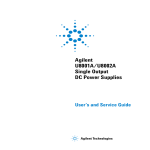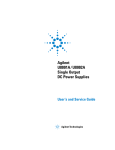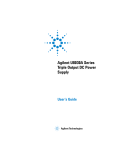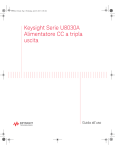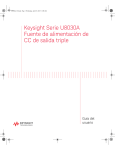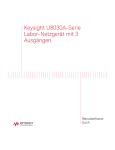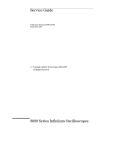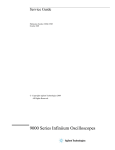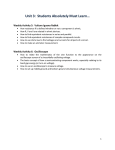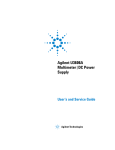Download Agilent Technologies U8030A Series Technical data
Transcript
Agilent U8030A Series Triple Output DC Power Supply Service Guide Agilent Technologies Notices © Agilent Technologies, Inc. 2012 Warranty No part of this manual may be reproduced in any form or by any means (including electronic storage and retrieval or translation into a foreign language) without prior agreement and written consent from Agilent Technologies, Inc. as governed by United States and international copyright laws. The material contained in this document is provided “as is,” and is subject to change, without notice, in future editions. Further, to the maximum extent permitted by the applicable law, Agilent disclaims all warranties, either express or implied, with regard to this manual and any information contained herein, including but not limited to the implied warranties of merchantability and fitness for a particular purpose. Agilent shall not be liable for errors or for incidental or consequential damages in connection with the furnishing, use, or performance of this document or of any information contained herein. Should Agilent and the user have a separate written agreement with warranty terms covering the material in this document that conflict with these terms, the warranty terms in the separate agreement shall control. Manual Part Number U8031-90013 Edition First Edition, March 20, 2012 Agilent Technologies, Inc. 5301, Stevens Creek Blvd. Santa Clara, CA 95051 USA Technology Licenses The hardware and or software described in this document are furnished under a license and may be used or copied only in accordance with the terms of such license. Restricted Rights Legend U.S. Government Restricted Rights. Software and technical data rights granted to the federal government include only those rights customarily provided to end user customers. Agilent provides this customary commercial license in Software and technical data pursuant to FAR 12.211 (Technical Data) and 12.212 (Computer Software) and, for the Department of Defense, DFARS 252.227-7015 (Technical Data - Commercial Items) and DFARS 227.7202-3 (Rights in Commercial Computer Software or Computer Software Documentation). II Safety Notices CAUTION A CAUTION notice denotes a hazard. It calls attention to an operating procedure, practice, or the likes of that, if not correctly performed or adhered to, could result in damage to the product or loss of important data. Do not proceed beyond a CAUTION notice until the indicated conditions are fully understood and met. WA R N I N G A WARNING notice denotes a hazard. It calls attention to an operating procedure, practice, or the likes of that, if not correctly performed or adhered to, could result in personal injury or death. Do not proceed beyond a WARNING notice until the indicated conditions are fully understood and met. U8030A Series Service Guide Safety Symbols The following symbols on the instrument and in the documentation indicate precautions which must be taken to maintain safe operation of the instrument. Caution, risk of danger (refer to this manual for specific Warning or Caution information) In position of a bi-stable push control DC (Direct current or voltage) Terminal is at earth potential. Used for measurement and control circuits designed to be operated with one terminal at earth potential. AC (Alternating current or voltage) Positive binding post Protective conductor terminal Negative binding post Out position of a bi-stable push control U8030A Series Service Guide III Safety Considerations Read the information below before using this instrument. The following general safety precautions must be observed during all phases of operation, service, and repair of this instrument. Failure to comply with these precautions or with specific warnings elsewhere in this manual violates safety standards for design, manufacture, and intended use of the instrument. Agilent Technologies assumes no liability for the customer’s failure to comply with these requirements. CAUTION • Use the device with the cables provided with the shipment. • If the device is used in a manner not specified by the manufacturer, the device protection may be impaired. • Always use dry cloth to clean the device. Do not use ethyl alcohol or any other volatile liquid to clean the device. • Do not permit any blockage of the ventilation holes of the device. WA R N I N G • Do not use the device if it appears damaged or defective. • Do not operate the device around flammable gases or fumes, vapor, or wet environments. • Observe all markings on the device before connecting any wiring to the device. • Turn off the output of the power supply before connecting to the output terminals. • When servicing the device, use only the specified replacement parts. • Do not install substitute parts or perform any unauthorized modification to the device. • Do not operate the device with the cover removed or loosened. • Use only the power adapter provided by the manufacturer to avoid any unexpected hazards. IV U8030A Series Service Guide Environmental Conditions This instrument is designed for indoor use and in an area with low condensation. The table below shows the general environmental requirements for this instrument. NOTE Environmental condition Requirements Operating temperature 0 °C to 40 °C Storage temperature –40 °C to 70 °C Humidity 15% RH (relative humidity) to 85% RH at 40 °C (non-condensing) Altitude Up to 2000 meters Installation category Installation Category II Pollution degree Pollution Degree 2 The U8030A Series Triple Output DC Power Supply complies with the following safety and EMC requirements: • • • • • • • U8030A Series Service Guide IEC61326-1:2005 / EN61326-1:2006 CISPR 11:2003/ EN55011:2007 Canada: ICES/NMB-001: Issue 4, June 2006 Australia / New Zealand: AS/NZS CISPR11:2004 IEC 61010-1:2001 / EN 61010-1:2001 (2nd Edition) Canada: CAN/CSA-C22.2 No. 61010-1-04 USA: ANSI/UL 61010-1:2004 V Regulatory Markings VI The CE mark is a registered trademark of the European Community. This CE mark shows that the product complies with all the relevant European Legal Directives. The C-tick mark is a registered trademark of the Spectrum Management Agency of Australia. This signifies compliance with the Australia EMC Framework regulations under the terms of the Radio Communication Act of 1992. ICES/NMB-001 indicates that this ISM device complies with the Canadian ICES-001. Cet appareil ISM est confomre a la norme NMB-001 du Canada. This instrument complies with the WEEE Directive (2002/96/EC) marking requirement. This affixed product label indicates that you must not discard this electrical or electronic product in domestic household waste. The CSA mark is a registered trademark of the Canadian Standards Association. This symbol indicates the time period during which no hazardous or toxic substance elements are expected to leak or deteriorate during normal use. Forty years is the expected useful life of the product. U8030A Series Service Guide Waste Electrical and Electronic Equipment (WEEE) Directive 2002/96/EC This instrument complies with the WEEE Directive (2002/96/EC) marking requirement. This affixed product label indicates that you must not discard this electrical or electronic product in domestic household waste. Product Category: With reference to the equipment types in the WEEE directive Annex 1, this instrument is classified as a “Monitoring and Control Instrument” product. The affixed product label is as shown below. Do not dispose in domestic household waste. To return this unwanted instrument, contact your nearest Agilent Service Center, or visit www.agilent.com/environment/product for more information. U8030A Series Service Guide VII Declaration of Conformity (DoC) The Declaration of Conformity (DoC) for this instrument is available on the Agilent website. You can search the DoC by its product model or description at the web address below. http://regulations.corporate.agilent.com/DoC/search.htm NOTE VIII If you are unable to search for the respective DoC, please contact your local Agilent representative. U8030A Series Service Guide Table of Contents 1 Calibration Procedures Agilent Calibration Services 2 Calibration interval 2 Other recommendations for calibration Recommended Test Equipment Test Considerations 2 3 5 Measurement Techniques 6 Performance Verification Tests 10 Constant voltage (CV) verification Constant current (CC) verification 10 17 Performance Test Record for U8031A 23 Performance Test Record for U8032A 26 Using the Front Panel for Adjustments 29 Calibration procedure 29 Restarting the calibration procedure 33 Toggling between channels and calibration modes Exiting the calibration mode 34 List of Error Codes 35 System errors 35 Power channel errors U8030A Series Service Guide 34 35 IX 2 Service and Maintenance Troubleshooting 38 Line Voltage Conversion Self-Test Procedure 39 40 Returning the Instrument for Service Replaceable Parts 42 To order replaceable parts 41 43 Types of Service Available 44 Extended service contracts 44 Obtaining Repair Service (Worldwide) X 45 U8030A Series Service Guide List of Figures Figure 1-1 Figure 1-2 Figure 1-3 Figure 1-4 Figure 1-5 Figure 1-6 Figure 2-1 U8030A Series Service Guide Test setup (A) 6 Test setup (B) 6 Test setup (C) 7 Test setup (D) 8 Binding post side view 9 Graph of load transient response 17 Orientation of voltage selector for different voltage selection 39 XI THIS PAGE HAS BEEN INTENTIONALLY LEFT BLANK. XII U8030A Series Service Guide List of Tables Table 1-1 Table 1-2 Table 1-3 Table 1-4 Table 1-5 Table 1-6 Table 1-7 Table 2-1 Table 2-2 Table 2-3 U8030A Series Service Guide Recommended test equipment 3 U8031A CV performance test record 23 U8031A CC performance test record 24 U8032A CV performance test record 26 U8032A CC performance test record 27 List of system error codes 35 List of power channel error codes 35 Operating checklist 38 Line voltage fuse rating indicator for U8031A/U8032A 40 Replaceable parts for U8031A/U8032A 42 XIII THIS PAGE HAS BEEN INTENTIONALLY LEFT BLANK. XIV U8030A Series Service Guide U8030A Series Triple Output DC Power Supply Service Guide 1 Calibration Procedures Agilent Calibration Services 2 Calibration interval 2 Other recommendations for calibration 2 Recommended Test Equipment 3 Test Considerations 5 Measurement Techniques 6 Performance Verification Tests 10 Constant voltage (CV) verification 10 Constant current (CC) verification 17 Performance Test Record for U8031A 23 Performance Test Record for U8032A 26 Using the Front Panel for Adjustments 29 Calibration procedure 29 Restarting the calibration procedure 33 Toggling between channels and calibration modes 34 Exiting the calibration mode 34 List of Error Codes 35 This chapter contains procedures for verifying the instrument performance, as well as procedures for making adjustments (calibration) where necessary. Agilent Technologies 1 1 Calibration Procedures Agilent Calibration Services Agilent Calibration Services When your instrument is due for calibration, contact your local Agilent Service Center for recalibration. See “Types of Service Available” on page 44 for more information on the various calibration services offered. Calibration interval The instrument should be calibrated on a regular interval determined by the measurement accuracy requirements of your application. A one- year interval is adequate for most applications. Accuracy specifications are warranted only if calibration is performed at regular intervals. Accuracy specifications are not warranted beyond the one- year calibration interval. Agilent does not recommend extending calibration intervals beyond two years for any application. Other recommendations for calibration Specifications are only guaranteed within the specified period from the last calibration. Agilent recommends that readjustment should always be performed at whatever calibration interval you select. This will ensure that the instrument remains within its specifications until the next calibration. This calibration criterion provides the best long- term stability. During performance verification tests, only the performance data is collected; these tests do not guarantee that the instrument will remain within the specified limits. The tests are only for identifying which functions need adjustment. 2 U8030A Series Service Guide Calibration Procedures Recommended Test Equipment 1 Recommended Test Equipment The test equipment recommended for the performance verification and adjustment procedures is listed below in Table 1- 1. If the exact instrument is not available, substitute with another calibration standard of equivalent accuracy. Table 1-1 Recommended test equipment Equipment Requirement(s) Digital multimeter (DMM) 8½ digits resolution Oscilloscope • Sensitivity: 1 mV • Bandwidth limit: 20 MHz • Probe: • 1:1 with RF tip • 10:1 with RF tip for > 50 V Differential amplifier • Bandwidth > 20 MHz (bandwidth limit: 20 MHz) • AC coupling • Amplifier × 10 RMS volt meter 20 Hz to 20 MHz 50 Ω feed-through termination Used[1] Recommended model Purpose Agilent 3458A Measures accurate DC voltage Agilent DSO8064A or Infiniium equivalent Displays transient response. Displays ripple and noise waveform. PV LeCroy DA1855A Signal conditioning preamplifiers PV R&S URE3 Measures RMS noise PV - Pomona Loads termination to match output impedance of the differential amplifier PV AC/DC current converter - Tektronix TCP305 and Tektronix TCPA300 Converts current to voltage PV Electronic load • • • • Voltage range: 60 Vdc Current range: 6 A Open and Short switches Transient On/Off Agilent 6060B Measures load and line regulations and transient response time PV AC power source Capable of supplying 90 Vac to 250 Vac Agilent 6813B Functions as variable voltage transformer PV U8030A Series Service Guide PV C 3 1 Calibration Procedures Recommended Test Equipment Table 1-1 Recommended test equipment (continued) Equipment Requirement(s) Resistive load (RL) • 5 Ω/180 W (for U8031A) • 20 Ω/180 W (for U8032A) • 1.67 Ω/15 W (for 5 V Output 3) Current monitoring resistor (shunt) (RM) • 0.01 Ω ± 0.1% • TCR less than 20 ppm/ºC Recommended model Purpose Used[1] - Measures ripple and noise PV ISOTEK Co. Model A-H Current monitoring resistor PV C [1] PV: Performance Verification, see page 10 for more information. C: Calibration, see page 29 for more information. 4 U8030A Series Service Guide Calibration Procedures Test Considerations 1 Test Considerations For optimum performance, all procedures should comply with the following recommendations: • Ensure that the calibration ambient temperature is stable and is recommended at 23 °C ± 2 °C. • Ensure that the ambient relative humidity is less than 80%. • Allow a warm- up period of 1 hour by powering on the power supply. During the warm- up period, set the power supply to its maximum programmable voltage and current. Then, enable the output. • Keep the test setup connection cables as short as possible. U8030A Series Service Guide 5 1 Calibration Procedures Measurement Techniques Measurement Techniques Test setup Most tests are performed at the front terminals as shown below. Measure the DC voltage directly at the positive (+) and negative (–) terminals on the front panel. DC voltmeter or scope + + – – + – Electronic load or resistor Figure 1-1 Test setup (A) + + – Current shunt DC voltmeter – + – Electronic load or resistor Figure 1-2 Test setup (B) 6 U8030A Series Service Guide Calibration Procedures Measurement Techniques + 1 – Load resistor BNC BNC + – Differential amplifier output BNC 50 Ω termination Input scope or RMS voltmeter Figure 1-3 Test setup (C) U8030A Series Service Guide 7 1 Calibration Procedures Measurement Techniques + – Load resistor TCP305 BNC TCPA300 BNC AC/DC converter 50 Ω termination Differential amplifier output BNC 50 Ω termination RMS voltmeter Figure 1-4 Test setup (D) Current monitoring resistor To eliminate output current measurement error caused by the voltage drops in the leads and connections, connect the current monitoring resistor (RM) between the (–) output terminal and the load as a four- terminal device. Connect the current monitoring leads inside the load- lead connections directly at the monitoring points on the resistor element. 8 U8030A Series Service Guide Calibration Procedures Measurement Techniques 1 General measurement techniques To achieve best results when measuring load regulation, peak to peak voltage, and transient response time of the power supply, measuring devices must be connected through the hole in the neck of the binding post at (A) while the load resistor is plugged into the front of the output terminals at (B). A measurement made across the load includes the impedance of the leads to the load. The impedance of the load leads can easily be several orders of magnitude greater than the power supply impedance and thus invalidate the measurement. To avoid mutual coupling effects, each measuring device must be connected directly to the output terminals by separate pairs of leads. Output terminal B A Figure 1-5 Binding post side view Electronic load Many of the test procedures require the use of a variable load resistor capable of dissipating the required power. Using a variable load resistor requires that switches should be used to connect, disconnect, and short the load resistor. An electronic load, if available, can be used in place of a variable load resistor and switches. The electronic load is considerably easier to use than load resistors. It eliminates the need for connecting resistors or rheostats in parallel to handle power, it is much more stable than a carbon- pile load, and it makes easy work of switching between load conditions as is required for the load regulation and load response tests. The substitution of the electronic load requires minor changes to the test procedures in this chapter. U8030A Series Service Guide 9 1 Calibration Procedures Performance Verification Tests Performance Verification Tests Use the performance verification tests to verify the measurement performance of the instrument. The performance verification tests use the instrument's specifications listed in the U8030A Series User's Guide (available for download at www.agilent.com/find/U8030). The performance verification tests are recommended as acceptance tests when you first receive the instrument. The acceptance test results should be compared against the one- year test limits. After acceptance, you should repeat the performance verification tests at every calibration interval. If the power supply fails the performance verification tests, adjustment or repair is required. NOTE Ensure that you have read the “Test Considerations” on page 5 before running the performance verification tests. Constant voltage (CV) verification Voltage programming and readback accuracy This test is to verify that the voltage programming and readback accuracy are within the published specifications. Procedure: 1 Power off the power supply, and connect a multimeter between the (+) and (–) terminals of the output to be tested. Remove the electronic load or resistor block as shown in Figure 1- 1, to operate it as an open circuit. 2 Power on the power supply. 3 When the power supply is in the limit mode, program the output voltage to 0 V and the output current to the maximum programmable value. 4 Enable the output. 10 U8030A Series Service Guide Calibration Procedures Performance Verification Tests 1 5 Wait a few seconds for the output of the power supply to settle. Ensure that the power supply is in the CV mode. 6 Record the voltage reading on the multimeter (VDMM). This value should be within the limit of • 0 V ± 15 mV for Output 1 and Output 2, and • 0 V ± 0.25 V for Output 3. 7 When the power supply is in the meter mode, record the voltage reading shown on the power supply. This value should be within the limit of VDMM ± 10 mV for Output 1 and Output 2. 8 Disable the output. 9 When the power supply is in limit mode, program the output voltage to its full rated value, i.e., • 30 V for U8031A, • 60 V for U8032A, and • 5 V for Output 3. 10 Enable the output. 11 Wait for a few seconds for the output of the power supply to settle. Ensure that the power supply is in the CV mode. 12 Record the voltage reading on the multimeter (VDMM). This value should be within the limit of • 30 V ± 0.09 V for U8031A, • 60 V ± 0.165 V for U8032A, and • 5 V ± 0.25 V for Output 3. 13 When the power supply is in the meter mode, record the voltage reading shown on the power supply. This value should be within the limit of • VDMM ± 0.09 V for U8031A, and • VDMM ± 0.165 V for U8032A. U8030A Series Service Guide 11 1 Calibration Procedures Performance Verification Tests CV load effect (load regulation) This test measures the change in the output voltage resulting from a change in the output current from full load to no load or vice versa. Procedure: 1 Power off the power supply, and connect a multimeter between the (+) and (–) terminals of the output as shown in Figure 1- 1. 2 Power on the power supply. 3 When the power supply is in the limit mode, program the output voltage to its full rated value (i.e., 30 V for U8031A, 60 V for U8032A, and 5 V for Output 3) and the output current to the maximum programmable value. 4 Enable the output. 5 Operate the electronic load in the CC mode, and set its current to 6 A for U8031A, 3 A for U8032A, and 3 A for Output 3. Ensure that the power supply is in the CV mode. If not, adjust the electronic load so that the current drops slightly until the power supply is in the CV mode. 6 Record the reading on the multimeter. 7 Within a few seconds after step 6, operate the electronic load in open mode and record the reading on the multimeter. 8 Compare the reading obtained in step 5 and step 6 with the reading obtained in step 7. The difference should be within the limit of • 5 mV for U8031A, • 8 mV for U8032A, and • ≤ 5 mV for Output 3. 12 U8030A Series Service Guide Calibration Procedures Performance Verification Tests 1 CV source effect (line regulation) This test measures the change in the output voltage that results from a change in the AC line voltage from its minimum value to its maximum value. Procedure: 1 Power off the power supply, and connect a multimeter between the (+) and (–) terminals of the output to be tested as shown in Figure 1- 1. 2 Connect the AC power line through an AC voltage source. Adjust the AC voltage source to provide a nominal input voltage to the power supply. 3 Power on the power supply. 4 When the display is in the limit mode, program the output voltage to its full rated value (i.e., 30 V for U8031A and 60 V for U8032A, and 5 V for Output 3) and the output current to the maximum programmable value. 5 Enable the output. 6 Operate the electronic load in the CC mode, and set its current to • 6 A for U8031A, • 3 A for U8032A, and • 3 A for Output 3. Ensure that the power supply is in the CV mode. If not, adjust the electronic load so that the output current drops slightly until the power supply is in the CV mode. 7 Adjust the AC voltage source to its low line voltage limit. Record the output reading on the multimeter. 8 Within a few seconds after step 7, adjust the AC voltage source to its high line voltage limit, and record the voltage reading on the multimeter. U8030A Series Service Guide 13 1 Calibration Procedures Performance Verification Tests 9 The difference between the multimeter readings in step 7 and step 8 should be within the limit of • 5 mV for U8031A, • 8 mV for U8032A, and • ≤ 5 mV for Output 3. Line voltage, Vac Low line voltage limit, Vac High line voltage limit, Vac 100 90 110 115 104 127 230 207 253 CV noise CV noise is specified as the RMS or peak- to- peak output voltage in the frequency range from 20 Hz to 20 MHz. Procedure: 1 Power off the power supply, and connect the output to be tested as shown in Figure 1- 3 to a differential amplifier and load resistor (5 Ω for U8031A, 20 Ω for U8032A, and 1.67 Ω for Output 3). 2 Power on the power supply. 3 When the display is in the limit mode, program the output voltage to its full rated value (i.e., 30 V for U8031A, 60 V for U8032A, and 5 V for Output 3) and output current to the maximum programmable value. 4 Enable the output of the power supply. 5 Ensure that the power supply is in the CV mode. If not, adjust the resistive load so that the output current drops slightly until the power supply is in the CV mode. 14 U8030A Series Service Guide Calibration Procedures Performance Verification Tests 1 6 Configure the differential amplifier as follows. • Enable the AC mode (positive and negative) to remove the DC component • Enable the differential mode • Set the gain to ×10 • Set the attenuation to 1 • Set the low- pass filter to 20 MHz bandwidth limit to filter out input signals that contain higher frequencies • Enable the zero precision voltage generator • Set the input impedance to 50 Ω 7 Configure the scope as follows. • Set the time range to 50 ms (20 Hz) • Acquire every single sample at the maximum sampling rate and retain only the minimum and maximum values in a “sampling region” (50 ms time range) • Enable the 20 MHz cut- off frequency for better high frequency cut- off • Enable AC coupling • Enable auto- triggering 8 Allow the scope run for a few seconds to generate enough measurement points. 9 Obtain the maximum peak- to- peak voltage measurement as indicated in the scope. Divide this value by 10 to get the CV peak- to- peak noise measurement. The result should not exceed • 10 mVpp for U8031A and U8032A, and • 50 mVpp for Output 3. 10 Configure the RMS voltmeter as follows. • Set the high- pass filter to 10 Hz • Enable AC coupling U8030A Series Service Guide 15 1 Calibration Procedures Performance Verification Tests 11 Disconnect the oscilloscope, and connect an RMS voltmeter in its place. Do not disconnect the 50 Ω termination. Divide the reading of the RMS voltmeter by 10. The result should not exceed the RMS limits of • 1 mVRMS for U8031A and U8032A, and • 2 mVRMS for Output 3. Load transient response time This test measures the time for the output voltage to recover to within 15 mV of the nominal output voltage following a load change from full load to half load or vice versa. Procedure: 1 Power off the power supply, and connect the output to be tested as shown in Figure 1- 1 with an oscilloscope. Operate the electronic load in the CC mode. 2 Power on the power supply. 3 When the display is in the limit mode, program the output voltage to full rated value (i.e., 30 V for U8031A and 60 V for U8032A) and the output current to the maximum programmable value. 4 Enable the output. 5 Set the electronic load to the transient operation mode between one half of the output's full rated value and the output's full rated value at a 1 kHz rate with 50% duty cycle. 6 Set the oscilloscope coupling, internal sync, and lock on to either the positive or negative load transient. 7 Adjust the oscilloscope to display transients as shown in Figure 1- 6. Note that the pulse width (t2 – t1) of the transients at 15 mV from the base line is no more than 50 μs for the output. 16 U8030A Series Service Guide Calibration Procedures Performance Verification Tests 1 Figure 1-6 Graph of load transient response Constant current (CC) verification Current programming and readback accuracy This test is to verify that the current programming and readback accuracy are within published specifications. The accuracy of the current monitoring resistor must be 0.1% or better. Procedure: 1 Power off the power supply, and connect a 0.01 Ω current shunt monitoring resistor (RM) across the output to be tested as shown in Figure 1- 2 and a multimeter across the current monitoring resistor (RM). 2 Power on the power supply. 3 When the power supply is in the limit mode, program the output voltage to the maximum programmable value and the current to 0 A. 4 Enable the output. U8030A Series Service Guide 17 1 Calibration Procedures Performance Verification Tests 5 Wait for a few seconds for the output of the power supply to settle. Ensure that the power supply is in the CC mode. 6 Divide the voltage drop (DMM reading) across the current monitoring resistor (RM) by its resistance to convert it to ampere and record this value (IO). This value should be within the limit of 0 A ± 15 mA. 7 When the power supply is in the meter mode, record the current reading shown on the power supply. This value should be within the limit of IO ± 10 mA. 8 Disable the output. 9 When the power supply is in the limit mode, program the output current to its full rated value, i.e., 6 A for U8031A and 3 A for U8032A. 10 Enable the output. 11 Wait for a few seconds for the output of the power supply to settle. Ensure that the power supply is in CC mode. 12 Divide the voltage drop (DMM reading) across the current monitoring resistor (RM) by its resistance to convert it to ampere and record this value (IO). This value should be within the limit of: • 6 A ± 33 mA for U8031A, and • 3 A ± 24 mA for U8032A. 13 When the power supply is in the meter mode, record the current reading shown on the power supply. This value should be within the limit of: • IO ± 25 mA for U8031A, and • IO ± 17.5 mA for U8032A. 18 U8030A Series Service Guide Calibration Procedures Performance Verification Tests 1 CC load effect (load regulation) This test measures the immediate change in the output current resulting from a change in the load from the full rated output voltage to a short circuit. Procedure: 1 Power off the power supply, and connect the output to be tested as shown in Figure 1- 2 with the multimeter connected across the 0.01 Ω current monitoring resistor (RM). 2 Power on the power supply. 3 When the power supply is in the limit mode, program the output voltage to its maximum programmable value and the output current to full rated value, i.e., 6 A for U8031A and 3 A for U8032A. 4 Enable the output. 5 Operate the electronic load in the CV mode, and set its voltage to 30 V for U8031A and 60 V for U8032A. Ensure that the power supply is in the CC mode. If not, adjust the electronic load so that the voltage drops slightly until the power supply is in the CC mode. 6 Allow the instrument to stabilize for 7 minutes before you record the current reading by dividing the voltage reading on the multimeter by the resistance of the current monitoring resistor. 7 Within a few seconds after step 6, operate the electronic load in the short mode, and allow the instrument to stabilize for 7 minutes before you record the current reading by dividing the voltage reading on the multimeter by the resistance of the current monitoring resistor. 8 Compare the reading obtained in step 6 and step 7. The difference should be within the limit of: • 3.2 mA for U8031A, and • 2.6 mA for U8032A. U8030A Series Service Guide 19 1 Calibration Procedures Performance Verification Tests CC source effect (line regulation) This test measures the change in the output current that results from a change in the AC line voltage from the minimum value to the maximum value. Procedure: 1 Power off the power supply, and connect the output to be tested as shown in step 1- 2 with the multimeter connected across the current monitoring resistor (RM). 2 Connect the AC power line through an AC voltage source. Adjust the AC voltage source to provide nominal input voltage to the power supply. 3 Power on the power supply. 4 When the display is in the limit mode, program the output voltage to the maximum programmable value and the output current to its full rated value, i.e., 6 A for U8031A and 3 A for U8032A. 5 Enable the output. 6 Operate the electronic load in the CV mode and set its voltage to 30 V for U8031A and 60 V for U8032A. Ensure that the power supply is in the CC mode. If not, adjust the electronic load so that the output voltage drops slightly until the power supply is in the CC mode. 7 Adjust the AC voltage source to the low line voltage limit. Allow the instrument to stabilize for 7 minutes before you record the output current reading by dividing the voltage reading on the multimeter by the resistance of the current monitoring resistor. 8 Within a few seconds after step 7, adjust the AC voltage source to the high line voltage limit and record the output current reading by dividing the voltage reading on the multimeter by the resistance of the current monitoring resistor. 20 U8030A Series Service Guide Calibration Procedures Performance Verification Tests 1 9 Compare the reading obtained in step 7 and step 8. The difference should be within the limit of: • 3.2 mA for U8031A, and • 2.6 mA for U8032A. Line voltage, Vac Low line voltage limit, Vac High line voltage limit, Vac 100 90 110 115 104 127 230 207 253 CC noise CC noise is specified as the RMS output current in a frequency range 20 Hz to 20 MHz with the power supply in the CC operation. Procedure: 1 Power off the power supply, and connect the output to be tested as shown in Figure 1- 4 to an AC/DC converter and load resistor (5 Ω for U8031A, 20 Ω for U8032A). 2 Power on the power supply. 3 When the display is in the limit mode, program the output voltage to the maximum programmable value and the output current to its full rated value, i.e., 6 A for U8031A and 3 A for U8032A. 4 Enable the output. 5 Ensure that the power supply is in the CC mode. If not, adjust the resistive load so that the output voltage drops slightly until the power supply is in the CC mode. U8030A Series Service Guide 21 1 Calibration Procedures Performance Verification Tests 6 Configure the differential amplifier as follows. • Enable the AC mode (positive and negative) to remove the DC component • Enable the differential mode • Set the gain to ×10 • Set the attenuation to 1 • Set the low- pass filter to 20 MHz bandwidth limit to filter out input signals that contain higher frequencies • Enable the zero precision voltage generator • Set input impedance to 50 Ω 7 Configure the RMS voltmeter as follows. • Set high- pass filter to 10 Hz • AC coupling 8 Divide the reading of the RMS voltmeter by 10, and then multiply the result by 5 to get the RMS noise measurement. The result should not exceed the RMS limits of 1 mARMS. 22 U8030A Series Service Guide Calibration Procedures Performance Test Record for U8031A 1 Performance Test Record for U8031A Table 1-2 U8031A CV performance test record Specifications Test description Actual result Upper limit Lower limit Output 1 +0.015 V –0.015 V Output 2 +0.015 V –0.015 V Output 3 +0.25 V –0.25 V Output 1 DVM + 0.010 V DVM – 0.010 V Output 2 DVM + 0.010 V DVM – 0.010 V Output 1 30.090 V 29.910 V Output 2 30.090 V 29.910 V Output 3 5.25 V 4.75 V Output 1 DVM + 0.085 V DVM – 0.085 V Output 2 DVM + 0.085 V DVM – 0.085 V CV programming accuracy @ 0 volts (DVM reading) CV readback accuracy @ 0 volts CV programming accuracy @ full scale (DVM reading) CV readback accuracy @ full scale CV load regulation Maximum change: Output 1 <5 mV Output 2 <5 mV Output 3 ≤5 mV U8030A Series Service Guide 23 1 Calibration Procedures Performance Test Record for U8031A Table 1-2 U8031A CV performance test record (continued) Specifications Test description Actual result Upper limit Lower limit CV line regulation Output 1 <5 mV Output 2 <5 mV Output 3 ≤5 mV CV ripple/noise Output 1 ≤10 mVPP, ≤1 mVRMS Output 2 ≤10 mVPP, ≤1 mVRMS Output 3 ≤50 mVPP, <2 mVRMS Load transient response time Output 1 <50 μs Output 2 Table 1-3 U8031A CC performance test record Specifications Test description Actual result Upper limit Lower limit Output 1 +0.015 A –0.015 A Output 2 +0.015 A –0.015 A Output 1 Io + 0.010 A Io – 0.010 A Output 2 Io + 0.010 A Io – 0.010 A CC programming accuracy @ 0 volts (Io) CC readback accuracy @ 0 volts 24 U8030A Series Service Guide Calibration Procedures Performance Test Record for U8031A 1 Table 1-3 U8031A CC performance test record (continued) Specifications Test description Actual result Upper limit Lower limit Output 1 6.033 A 5.967 A Output 2 6.033 A 5.967 A Output 1 Io + 0.0250 A Io – 0.0250 A Output 2 Io + 0.0250 A Io – 0.0250 A CC programming accuracy @ full scale (Io) CC readback accuracy @ full scale CC load regulation Maximum change: Output 1 <3.2 mA Output 2 <3.2 mA CC line regulation Maximum change: Output 1 <3.2 mA Output 2 <3.2 mA CC ripple/noise Output 1 ≤1 mARMS Output 2 ≤1 mARMS U8030A Series Service Guide 25 1 Calibration Procedures Performance Test Record for U8032A Performance Test Record for U8032A Table 1-4 U8032A CV performance test record Specifications Test description Actual result Upper limit Lower limit Output 1 +0.015 V –0.015 V Output 2 +0.015 V –0.015 V Output 3 +0.25 V –0.25 V Output 1 DVM + 0.010 V DVM – 0.010 V Output 2 DVM + 0.010 V DVM – 0.010 V Output 1 60.165 V 59.835 V Output 2 60.165 V 59.835 V Output 3 5.25 V 4.75 V Output 1 DVM + 0.165 V DVM – 0.165 V Output 2 DVM + 0.165 V DVM – 0.165 V CV programming accuracy @ 0 volts (DVM reading[1]) CV readback accuracy @ 0 volts CV programming accuracy @ full scale (DVM reading) CV readback accuracy @ full scale CV load regulation Maximum change: Output 1 <8 mV Output 2 <8 mV Output 3 ≤5 mV 26 U8030A Series Service Guide Calibration Procedures Performance Test Record for U8032A 1 Table 1-4 U8032A CV performance test record (continued) Specifications Test description Actual result Upper limit Lower limit CV line regulation Output 1 <8 mV Output 2 <8 mV Output 3 ≤5 mV CV ripple/noise Output 1 ≤10 mVPP, ≤1 mVRMS Output 2 ≤10 mVPP, ≤1 mVRMS Output 3 ≤50 mVPP, <2 mVRMS Load transient response time Output 1 <50 μs Output 2 [1] DVM: Digital Volt Meter Table 1-5 U8032A CC performance test record Specifications Test description Actual result Upper limit Lower limit Output 1 +0.015 A –0.015 A Output 2 +0.015 A –0.015 A Output 1 Io + 0.010 A Io – 0.010 A Output 2 Io + 0.010 A Io – 0.010 A CC programming accuracy @ 0 volts (Io) CC readback accuracy @ 0 volts U8030A Series Service Guide 27 1 Calibration Procedures Performance Test Record for U8032A Table 1-5 U8032A CC performance test record (continued) Specifications Test description Actual result Upper limit Lower limit Output 1 3.024 A 2.976 A Output 2 3.024 A 2.976 A Output 1 Io + 0.0175 A Io – 0.0175 A Output 2 Io + 0.0175 A Io – 0.0175 A CC programming accuracy @ full scale (Io) CC readback accuracy @ full scale CC load regulation Maximum change: Output 1 <2.6 mA Output 2 <2.6 mA CC line regulation Maximum change: Output 1 <2.6 mA Output 2 <2.6 mA CC ripple/noise 28 Output 1 ≤1 mARMS Output 2 ≤1 mARMS U8030A Series Service Guide Calibration Procedures Using the Front Panel for Adjustments 1 Using the Front Panel for Adjustments This section describes the procedures to perform voltage and current adjustments (calibrations) from the front panel of the power supply. Calibration procedure NOTE Review the “Test Considerations” before beginning the calibration procedure. 1 Press and hold the [Memory] button when powering on the power supply to begin the calibration procedure. 2 The calibration procedure starts with the voltage calibration for Output 1. NOTE Disconnect all loads from the power supply, and connect a digital volt meter (DVM) across the output terminals of Output 1. Voltage calibration for Output 1 1 The display shows the calibration setup screen. • All the outputs are disabled. The OFF annunciator turns on. • The OUT1 annunciator turns on. • The CV annunciator for Output 1 turns on. • The display shows SET UP on line 1 and CAL on line 2. The CAL annunciator blinks. 2 Press the [Memory] button. • Output 1 is enabled. The OFF annunciator turns off. • Ensure that the output is in the CV mode, otherwise the CC annunciator for Output 1 will blink and the calibration will not proceed. U8030A Series Service Guide 29 1 Calibration Procedures Using the Front Panel for Adjustments 3 Voltage calibration low point: • The M1 annunciator turns on. • Use the knob to enter the reading obtained from the DVM. • Press the [Memory] button to save the value. • The calibration proceeds to the next calibration point. 4 Voltage calibration high point: • The M2 annunciator turns on. • Use the knob to enter the reading obtained from the DVM. • Press the [Memory] button to save the value. 5 The voltage calibration for Output 1 is completed. • Output 1 is disabled. • The display shows DONE for a brief period of time. • The calibration procedure proceeds to the current calibration for Output 1. NOTE Connect an appropriate 0.01 Ω shunt resistor across the output terminals of Output 1, and connect a DVM across the shunt resistor. Current calibration for Output 1 1 The display shows the calibration setup screen. • All the outputs are disabled. The OFF annunciator turns on. • The OUT1 annunciator turns on. • The CC annunciator for Output 1 turns on. • The display shows SET UP on line 1 and CAL on line 2. The CAL annunciator blinks. 2 Press the [Memory] button. • Output 1 is enabled. The OFF annunciator turns off. 30 U8030A Series Service Guide Calibration Procedures Using the Front Panel for Adjustments 1 • Ensure that the output is in the CC mode, otherwise the CV annunciator for Output 1 will blink and the calibration will not proceed. 3 Current calibration low point: • The M1 annunciator turns on. • Use the knob to enter the calculated value (the DVM reading divided by the shunt resistance). • Press the [Memory] button to save the value. • The calibration proceeds to the next calibration point. 4 Current calibration high point: • The M2 annunciator turns on. • Use the knob to enter the calculated value (the DVM reading divided by the shunt resistance). • Press the [Memory] button to save the value. 5 The current calibration for Output 1 is completed. • Output 1 is disabled. • The display shows DONE for a brief period of time. • The calibration procedure proceeds to the voltage calibration for Output 2. NOTE Disconnect all loads from the unit, and connect a DVM across the output terminals of Output 2. Voltage calibration for Output 2 1 The display shows the calibration setup screen. • All the outputs are disabled. The OFF annunciator turns on. • The OUT2 annunciator turns on. • The CV annunciator for Output 2 turns on. • The display shows SET UP on line 1 and CAL on line 2. The CAL annunciator blinks. 2 Press the [Memory] button. U8030A Series Service Guide 31 1 Calibration Procedures Using the Front Panel for Adjustments • Output 2 is enabled. The OFF annunciator turns off. • Ensure that the output is in the CV mode, otherwise the CC annunciator for Output 2 will blink and the calibration will not proceed. 3 Voltage calibration low point: • The M1 annunciator turns on. • Use the knob to enter the reading obtained from the DVM. • Press the [Memory] button to save the value. • The calibration proceeds to the next calibration point. 4 Voltage calibration high point: • The M2 annunciator turns on. • Use the knob to enter the reading obtained from the DVM. • Press the [Memory] button to save the value. 5 The voltage calibration for Output 2 is completed. • Output 2 is disabled. • The display shows DONE for a brief period of time. • The calibration procedure proceeds to the current calibration for Output 2. NOTE Connect an appropriate 0.01 Ω shunt resistor across the output terminals of Output 2, and connect a DVM across the shunt resistor. Current calibration for Output 2 1 The display shows the calibration setup screen. • All the outputs are disabled. The OFF annunciator turns on. • The OUT2 annunciator turns on. • The CC annunciator for Output 2 turns on. • The display shows SET UP on line 1 and CAL on line 2. The CAL annunciator blinks. 32 U8030A Series Service Guide Calibration Procedures Using the Front Panel for Adjustments 1 2 Press the [Memory] button. • Output 2 is enabled. The OFF annunciator turns off. • Ensure that the output is in the CC mode, otherwise the CV annunciator for Output 2 will blink and the calibration will not proceed. 3 Current calibration low point: • The M1 annunciator turns on. • Use the knob to enter the calculated value (the DVM reading divided by the shunt resistance). • Press the [Memory] button to save the value. • The calibration proceeds to the next calibration point. 4 Current calibration high point: • The M2 annunciator turns on. • Use the knob to enter the calculated value (the DVM reading divided by the shunt resistance). • Press the [Memory] button to save the value. 5 The current calibration for Output 2 is completed. • Output 2 is disabled. • The display shows DONE for a brief period of time. • The entire calibration procedure is now completed. • The display shows DONE CAL. 6 Verify the calibrations using the “Performance Verification Tests” on page 10. Restarting the calibration procedure After the calibration procedure is completed, it can be restarted by pressing the [Memory] button. The calibration procedure will restart with the voltage calibration for Output 1. U8030A Series Service Guide 33 1 Calibration Procedures Using the Front Panel for Adjustments Toggling between channels and calibration modes To select the output channel for calibration, press the [1] or [2] button. When the output channel is changed, the calibration will always start with the voltage calibration mode. During the calibration, pressing the [Voltage/Current] button will toggle between the voltage calibration mode and current calibration mode. Exiting the calibration mode 1 Remove all the shunt resistors and connectors from the instrument. 2 Power off and on again. The instrument will return to normal operation. 34 U8030A Series Service Guide Calibration Procedures List of Error Codes 1 List of Error Codes The following errors indicate failures that may occur while operating the power supply. System errors Table 1-6 List of system error codes Error code Description 001 Failed firmware test 002 Failed RAM test 003 Flash read/write error Power channel errors Table 1-7 List of power channel error codes U8030A Series Service Guide Error code Description 104 EEPROM write error 105 Analog board firmware update error 106 Analog board firmware checksum error 107 EEPROM read error 108 Failed to calibrate voltage DAC 109 Failed to calibrate voltage ADC 110 Failed to calibrate OVP 111 Failed to calibrate current DAC 112 Failed to calibrate current ADC 35 1 Calibration Procedures List of Error Codes Table 1-7 List of power channel error codes (continued) 36 Error code Description 113 Failed to calibrate OCP 119 Analog board unknown error 120 Over temperature 130 Failed EEPROM test 131 Failed voltage +15 V 132 Failed voltage +5 V 133 Failed voltage +2.5 VREF 134 Failed voltage +1 VREF 135 Failed ADC test 136 Failed DAC test 140 Failed communication with analog board 141 Unsupported analog board U8030A Series Service Guide U8030A Series Triple Output DC Power Supply Service Guide 2 Service and Maintenance Troubleshooting 38 Line Voltage Conversion 39 Self-Test Procedure 40 Returning the Instrument for Service 41 Replaceable Parts 42 To order replaceable parts 43 Types of Service Available 44 Extended service contracts 44 Obtaining Repair Service (Worldwide) 45 This chapter will help you troubleshoot a failing instrument. It also describes how to obtain repair services and lists the replaceable assemblies. Agilent Technologies 37 2 Service and Maintenance Troubleshooting Troubleshooting WA R N I N G To avoid electrical shock, do not perform any service unless you are qualified to do so. This section provides a brief check list of the common failures. Before troubleshooting or repairing the power supply, make sure that the failure is in the instrument rather than any external connections. Also make sure that the instrument is accurately calibrated. The table below will assist you in identifying some basic malfunctions. Table 2-1 Operating checklist Malfunction Identification ❏ Verify that the AC power cord is connected to the power supply. Unit is inoperative ❏ Verify that the front panel power switch is at the ON position. ❏ Verify the power- line voltage setting. ❏ Verify that the power- line fuse is installed.[1] [1] See Table 2-3 on page 42 for more information on the power-line fuse part number and description. 38 U8030A Series Service Guide Service and Maintenance Line Voltage Conversion 2 Line Voltage Conversion WA R N I N G SHOCK HAZARD Operating personnel must not remove power supply covers. Component replacement and internal adjustment must be made only by qualified service personnel. Line voltage conversion is accomplished by adjusting one component: the line voltage selection switch. To convert the supply from one line voltage option to another, proceed as follows. 1 Turn off the power supply, and disconnect the power cord. 2 Select the desired line voltage with the line voltage selection switch AC Selector 100V/115V 230 V Figure 2-1 Orientation of voltage selector for different voltage selection U8030A Series Service Guide 39 2 Service and Maintenance Self-Test Procedure Table 2-2 Line voltage fuse rating indicator for U8031A/U8032A Fuse Rating: 47-63 Hz 600 VA ~ Line 100 V 1.0 AT 115 V 230 V NOTE The authorized personnel will mark the fuse rating indicator printed on the rear panel each time the fuse is changed. Self-Test Procedure Power-on self-test Each time the power supply is powered on, a set of self- tests is performed. These tests check that the minimum set of logic and measurement hardware are functioning properly. If the unit fails the power-on self-test Verify that the correct power- line voltage setting is selected. Also, ensure that all terminal connections are removed while the power- on self- test is performed. Please refer to “List of Error Codes” on page 35 for the list of error codes. 40 U8030A Series Service Guide Service and Maintenance Returning the Instrument for Service 2 Returning the Instrument for Service Before shipping your instrument for repair or replacement, Agilent recommends that you acquire the shipping instructions from the Agilent Technologies Service Center. A clear understanding of the shipping instructions is necessary to secure your product for shipment. 1 Attach a tag to the instrument with the following information: • Name and address of the owner • Instrument model number • Instrument serial number • Description of the service required or failure indications 2 Remove all accessories from the instrument. Do not include accessories unless they are associated with the failure symptoms. 3 Place the instrument in its original container with appropriate packaging material for shipping. If the original shipping container is not available, place your unit in a container which will ensure at least 4 inches of compressible packaging material around all sides for the instrument. Use static- free packaging materials to avoid additional damage to your unit. NOTE U8030A Series Service Guide Agilent suggests that you always insure your shipments. 41 2 Service and Maintenance Replaceable Parts Replaceable Parts This section contains information for ordering replacement parts for your instrument. You can find the instrument support part list in the Agilent's Test & Measurement Parts Catalog at http://www.agilent.com/find/parts Table 2- 3 include a brief description of each part with the applicable Agilent part number. Table 2-3 Replaceable parts for U8031A/U8032A Part number 2110-1504 42 Description FUSE 1 A 250 V TIME-DELAY 0.0757-OHM 20 × 5.2 × 5.2-MM U8031-48001 RUBBER KEYPAD E3632-40003 KNOB 5190-3459 FUSE HOLDER 0371-3806 AC SWITCH KEY CAP U8031-30001 LCD MODULE U8031-66504 DISPLAY PCA U8031-68501 DC FAN ASSEMBLY 5041-9172 TRIM SIDE E3631-61201 STRAP HANDLE ASSEMBLY U8030A Series Service Guide Service and Maintenance Replaceable Parts 2 To order replaceable parts You can order replaceable parts from Agilent using the Agilent part number. Note that not all parts listed are available as field- replaceable parts. To order replaceable parts from Agilent, do the following: 1 Contact your nearest Agilent Sales Office or Service Center. 2 Identify the parts by the Agilent part number shown in the support parts list. 3 Provide the instrument model number and serial number. U8030A Series Service Guide 43 2 Service and Maintenance Types of Service Available Types of Service Available If your instrument fails during the warranty period, Agilent Technologies will repair or replace it under the terms of your warranty. Extended service contracts Many Agilent products are available with optional service contracts that extend the covered period after the standard warranty expires. If you have such a service contract and your instrument fails during the covered period, Agilent Technologies will repair or replace it in accordance with the contract. 44 U8030A Series Service Guide Service and Maintenance Obtaining Repair Service (Worldwide) 2 Obtaining Repair Service (Worldwide) To obtain service for your instrument (in- warranty or under service contract), contact your nearest Agilent Technologies Service Center. They will arrange to have your unit repaired or replaced, and can provide warranty information where applicable. To obtain warranty, service, or technical support information you can contact Agilent Technologies at one of the following telephone numbers: • In the United States: (800) 829- 4444 • In Europe: 31 20 547 2111 • In Japan: 0120- 421- 345 Or use our web link for information on contacting Agilent worldwide: www.agilent.com/find/assist Or contact your Agilent Technologies Representative. Before shipping your instrument, ask the Agilent Technologies Service Center to provide shipping instructions, including what components to ship. Agilent recommends that you retain the original shipping carton for use in such shipments. U8030A Series Service Guide 45 2 Service and Maintenance Obtaining Repair Service (Worldwide) THIS PAGE HAS BEEN INTENTIONALLY LEFT BLANK. 46 U8030A Series Service Guide www.agilent.com Contact us To obtain service, warranty, or technical assistance, contact us at the following phone or fax numbers: United States: (tel) 800 829 4444 (fax) 800 829 4433 Canada: (tel) 877 894 4414 (fax) 800 746 4866 China: (tel) 800 810 0189 (fax) 800 820 2816 Europe: (tel) 31 20 547 2111 Japan: (tel) (81) 426 56 7832 (fax) (81) 426 56 7840 Korea: (tel) (080) 769 0800 (fax) (080) 769 0900 Latin America: (tel) (305) 269 7500 Taiwan: (tel) 0800 047 866 (fax) 0800 286 331 Other Asia Pacific Countries: (tel) (65) 6375 8100 (fax) (65) 6755 0042 Or visit Agilent World Wide Web at: www.agilent.com/find/assist Product specifications and descriptions in this document are subject to change without notice. Always refer to the Agilent website for the latest revision. © Agilent Technologies, Inc., 2012 First Edition, March 20, 2012 U8031-90013 Agilent Technologies





























































